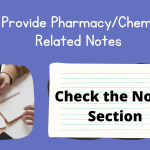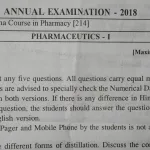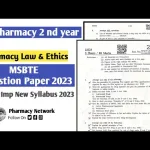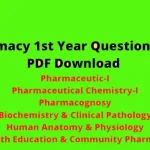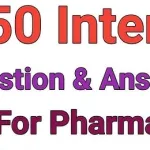D pharmacy 1st year syllabus includes essential topics across subjects like Pharmaceutics, Pharmaceutical Chemistry, Pharmacology, and Biology. This guide presents solved questions from the 2023 papers, covering key areas to help students understand and excel. Each subject contains a comprehensive set of questions and answers for thorough preparation.
Pharmaceutics
Question: What is the definition of pharmaceutics?
Answer:
Pharmaceutics is the science of formulating, manufacturing, and dispensing drugs in forms suitable for administration to patients.
Question: Define bioavailability.
Answer:
Bioavailability refers to the extent and rate at which an active drug ingredient is absorbed and becomes available at the site of action.
Question: What is the purpose of preservatives in pharmaceuticals?
Answer:
Preservatives are added to pharmaceutical formulations to prevent microbial growth and extend the shelf life of the product.
Question: Describe isotonicity in solutions.
Answer:
Isotonicity refers to the state where the osmotic pressure of a solution matches that of body fluids, preventing tissue damage during administration.
Question: What is the role of binders in tablet formulation?
Answer:
Binders help hold the components of a tablet together, providing structural integrity.
Question: Define sustained-release formulations.
Answer:
Sustained-release formulations are designed to release a drug slowly over an extended period to maintain therapeutic levels.
Question: Explain the term ‘granulation’ in tablet manufacturing.
Answer:
Granulation is the process of forming granules to ensure uniform distribution of ingredients in a tablet.
Question: What is an emulsion?
Answer:
An emulsion is a mixture of two immiscible liquids stabilized by an emulsifying agent.
Question: Name two methods of sterilization commonly used in pharmaceuticals.
Answer:
The two methods are autoclaving (steam sterilization) and filtration sterilization.
Question: Define disintegration time.
Answer:
Disintegration time is the time required for a tablet to break down into smaller fragments in a liquid medium.
Question: What are suppositories?
Answer:
Suppositories are solid dosage forms intended for insertion into body orifices where they melt or dissolve to release the drug.
Question: Explain the purpose of coating tablets.
Answer:
Coating tablets can protect the drug, mask the taste, or control the drug’s release profile.
Question: What are the common types of capsules?
Answer:
The common types are hard gelatin capsules and soft gelatin capsules.
Question: Define the term ‘vehicle’ in pharmaceuticals.
Answer:
A vehicle is a carrier or medium used to deliver the active ingredient in a drug formulation.
Question: What are aerosols?
Answer:
Aerosols are pressurized dosage forms that release medication as a fine mist or spray.
Question: Explain the concept of viscosity in liquid formulations.
Answer:
Viscosity measures a fluid’s resistance to flow and affects the stability and delivery of liquid formulations.
Question: What is lyophilization?
Answer:
Lyophilization is a freeze-drying process used to stabilize pharmaceutical products.
Question: What is a transdermal patch?
Answer:
A transdermal patch is a medicated adhesive patch applied to the skin to deliver drugs systemically.
Question: Mention one advantage of parenteral dosage forms.
Answer:
Parenteral dosage forms bypass the gastrointestinal tract, providing rapid drug action.
Pharmaceutical Chemistry
Question: Define the term ‘buffer solution.’
Answer:
A buffer solution resists changes in pH when small amounts of acid or base are added.
Question: What is the role of a catalyst in a chemical reaction?
Answer:
A catalyst increases the reaction rate without being consumed in the process.
Question: Define molarity.
Answer:
Molarity is the number of moles of solute dissolved in one liter of solution.
Question: What is the principle of acid-base titration?
Answer:
Acid-base titration involves neutralizing an acid with a base (or vice versa) to determine its concentration.
Question: Name the functional group present in alcohols.
Answer:
The functional group in alcohols is the hydroxyl group (-OH).
Question: Explain the term ‘oxidation.’
Answer:
Oxidation is the loss of electrons or an increase in the oxidation state of an atom or molecule.
Question: What is the purpose of using indicators in titration?
Answer:
Indicators help identify the endpoint of a titration by changing color.
Question: Define the term ‘electrolyte.’
Answer:
An electrolyte is a substance that dissociates into ions when dissolved in water, conducting electricity.
Question: What is a standard solution?
Answer:
A standard solution has a precisely known concentration, used for titration or calibration.
Question: Explain the principle of chromatography.
Answer:
Chromatography separates components of a mixture based on differences in their movement through a medium.
Question: What is the role of a reducing agent in a reaction?
Answer:
A reducing agent donates electrons and reduces another substance.
Question: Define the term ‘isomerism.’
Answer:
Isomerism refers to compounds with the same molecular formula but different structures or properties.
Question: What is meant by a covalent bond?
Answer:
A covalent bond forms when atoms share electron pairs to achieve stability.
Question: Explain the term ‘acidic buffer.’
Answer:
An acidic buffer maintains an acidic pH, typically made from a weak acid and its salt.
Question: What is a chelating agent?
Answer:
A chelating agent forms stable complexes with metal ions, often used in pharmaceuticals to enhance solubility or stability.
Question: Define the term ‘solubility.’
Answer:
Solubility is the maximum amount of a solute that can dissolve in a solvent at a given temperature.
Question: What is a salt bridge in electrochemistry?
Answer:
A salt bridge connects two half-cells in an electrochemical cell, allowing ion flow to maintain neutrality.
Question: What are aromatic compounds?
Answer:
Aromatic compounds are cyclic molecules with conjugated pi-electron systems and exhibit resonance stability.
Question: What is the pH scale used for?
Answer:
The pH scale measures the acidity or basicity of a solution, ranging from 0 to 14.
Latest Posts
- Step-by-step guide to download and apply for jee mains admit card 202
- Comprehensive 2025 government holidays and recruitment details for job seekers
- JEE Mains Admit Card 2025: Your Step-by-Step Guide to Downloading the Hall Ticket
- Everything You Need to Know About 2025 Government Holidays Recruitment
- Comprehensive Guide to rrb d group recruitment 2025 – Eligibility, Vacancies, and Application
- Detailed guide to nps trust recruitment 2025 vacancies, eligibility and apply process
- Comprehensive guide to hpcl recruitment 2025 notification, vacancies, and application process
- ignou bed admission 2025 complete recruitment guide with eligibility and process
- Comprehensive Guide to Indian Army Agniveer Recruitment 2025 Notification and Jobs
- Everything You Must Know About CBSE Board Exams 2025 Changes & New Rules


